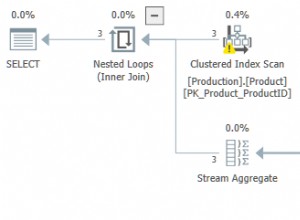Prueba esto:http://www.sqlfiddle.com/#!3/c3365/ 20
with s as
(
select *, row_number() over(partition by membercode order by startdate) rn
from tbl
)
,gaps as
(
select a.membercode, a.startdate, a.enddate, b.startdate as nextstartdate
,datediff(d, a.enddate, b.startdate) as gap
from s a
join s b on b.membercode = a.membercode and b.rn = a.rn + 1
)
select membercode
from gaps
group by membercode
having sum(case when gap <= 1 then 1 end) = count(*);
Consulte el progreso de la consulta aquí:http://www.sqlfiddle.com/#!3/ c3365/20
Cómo funciona, compare la fecha de finalización actual con su próxima fecha de inicio y verifique la brecha de fechas:
with s as
(
select *, row_number() over(partition by membercode order by startdate) rn
from tbl
)
select a.membercode, a.startdate, a.enddate, b.startdate as nextstartdate
,datediff(d, a.enddate, b.startdate) as gap
from s a
join s b on b.membercode = a.membercode and b.rn = a.rn + 1;
Salida:
| MEMBERCODE | STARTDATE | ENDDATE | NEXTSTARTDATE | GAP |
--------------------------------------------------------------
| 1 | 2010-01-15 | 2010-01-20 | 2010-01-19 | -1 |
| 1 | 2010-01-19 | 2010-01-22 | 2010-01-20 | -2 |
| 1 | 2010-01-20 | 2010-01-25 | 2010-01-26 | 1 |
| 2 | 2010-01-20 | 2010-01-25 | 2010-01-30 | 5 |
| 2 | 2010-01-30 | 2010-02-05 | 2010-02-04 | -1 |
Luego verifique si un miembro tiene la misma cantidad de reclamos sin brechas en sus reclamos totales:
with s as
(
select *, row_number() over(partition by membercode order by startdate) rn
from tbl
)
,gaps as
(
select a.membercode, a.startdate, a.enddate, b.startdate as nextstartdate
,datediff(d, a.enddate, b.startdate) as gap
from s a
join s b on b.membercode = a.membercode and b.rn = a.rn + 1
)
select membercode, count(*) as count, sum(case when gap <= 1 then 1 end) as gapless_count
from gaps
group by membercode;
Salida:
| MEMBERCODE | COUNT | GAPLESS_COUNT |
--------------------------------------
| 1 | 3 | 3 |
| 2 | 2 | 1 |
Finalmente, fíltrelos, miembros sin espacios en blanco en sus reclamos:
with s as
(
select *, row_number() over(partition by membercode order by startdate) rn
from tbl
)
,gaps as
(
select a.membercode, a.startdate, a.enddate, b.startdate as nextstartdate
,datediff(d, a.enddate, b.startdate) as gap
from s a
join s b on b.membercode = a.membercode and b.rn = a.rn + 1
)
select membercode
from gaps
group by membercode
having sum(case when gap <= 1 then 1 end) = count(*);
Salida:
| MEMBERCODE |
--------------
| 1 |
Tenga en cuenta que no necesita hacer COUNT(*) > 1 para detectar miembros con 2 o más reclamos. En lugar de usar LEFT JOIN , usamos JOIN , esto descartará automáticamente a los miembros que aún no tienen un segundo reclamo. Aquí está la versión (más larga) si opta por usar LEFT JOIN en su lugar (misma salida que arriba):
with s as
(
select *, row_number() over(partition by membercode order by startdate) rn
from tbl
)
,gaps as
(
select a.membercode, a.startdate, a.enddate, b.startdate as nextstartdate
,datediff(d, a.enddate, b.startdate) as gap
from s a
left join s b on b.membercode = a.membercode and b.rn = a.rn + 1
)
select membercode
from gaps
group by membercode
having sum(case when gap <= 1 then 1 end) = count(gap)
and count(*) > 1; -- members who have two ore more claims only
Así es como se ven los datos de la consulta anterior antes del filtrado:
with s as
(
select *, row_number() over(partition by membercode order by startdate) rn
from tbl
)
,gaps as
(
select a.membercode, a.startdate, a.enddate, b.startdate as nextstartdate
,datediff(d, a.enddate, b.startdate) as gap
from s a
left join s b on b.membercode = a.membercode and b.rn = a.rn + 1
)
select * from gaps;
Salida:
| MEMBERCODE | STARTDATE | ENDDATE | NEXTSTARTDATE | GAP |
-----------------------------------------------------------------
| 1 | 2010-01-15 | 2010-01-20 | 2010-01-19 | -1 |
| 1 | 2010-01-19 | 2010-01-22 | 2010-01-20 | -2 |
| 1 | 2010-01-20 | 2010-01-25 | 2010-01-26 | 1 |
| 1 | 2010-01-26 | 2010-01-30 | (null) | (null) |
| 2 | 2010-01-20 | 2010-01-25 | 2010-01-30 | 5 |
| 2 | 2010-01-30 | 2010-02-05 | 2010-02-04 | -1 |
| 2 | 2010-02-04 | 2010-02-15 | (null) | (null) |
| 3 | 2010-02-15 | 2010-03-02 | (null) | (null) |
EDITAR sobre aclaración de requisitos:
En su aclaración, quería incluir miembros que aún no tienen un segundo reclamo también, haga esto en su lugar:http://sqlfiddle.com/#!3/c3365/22
with s as
(
select *, row_number() over(partition by membercode order by startdate) rn
from tbl
)
,gaps as
(
select a.membercode, a.startdate, a.enddate, b.startdate as nextstartdate
,datediff(d, a.enddate, b.startdate) as gap
from s a
left join s b on b.membercode = a.membercode and b.rn = a.rn + 1
)
select membercode
from gaps
group by membercode
having sum(case when gap <= 1 then 1 end) = count(gap)
-- members who have yet to have a second claim are valid too
or count(nextstartdate) = 0;
Salida:
| MEMBERCODE |
--------------
| 1 |
| 3 |
La técnica es contar la nextstartdate del miembro , si no tienen la próxima fecha de inicio (es decir, count(nextstartdate) = 0 ) entonces son solo reclamos únicos y válidos también, luego simplemente adjunte este OR condición:
or count(nextstartdate) = 0;
En realidad, la condición a continuación también será suficiente, aunque quería que la consulta fuera más autodocumentada, por lo tanto, recomiendo contar con la próxima fecha de inicio del miembro. Aquí hay una condición alternativa para contar miembros que aún no tienen un segundo reclamo:
or count(*) = 1;
Por cierto, también tenemos que cambiar la comparación de esto:
sum(case when gap <= 1 then 1 end) = count(*)
a esto (ya que estamos usando LEFT JOIN ahora):
sum(case when gap <= 1 then 1 end) = count(gap)




